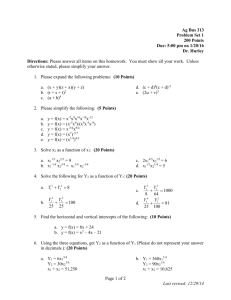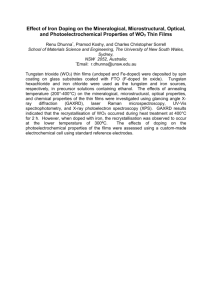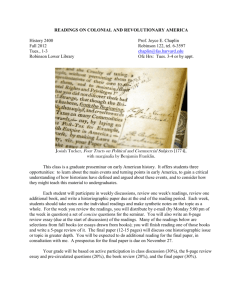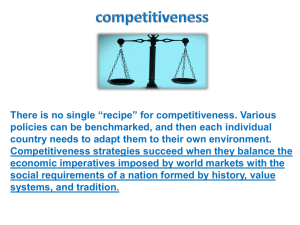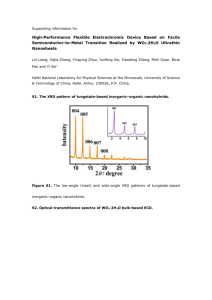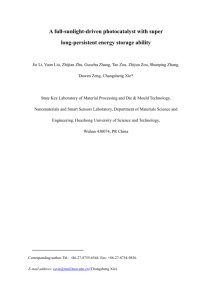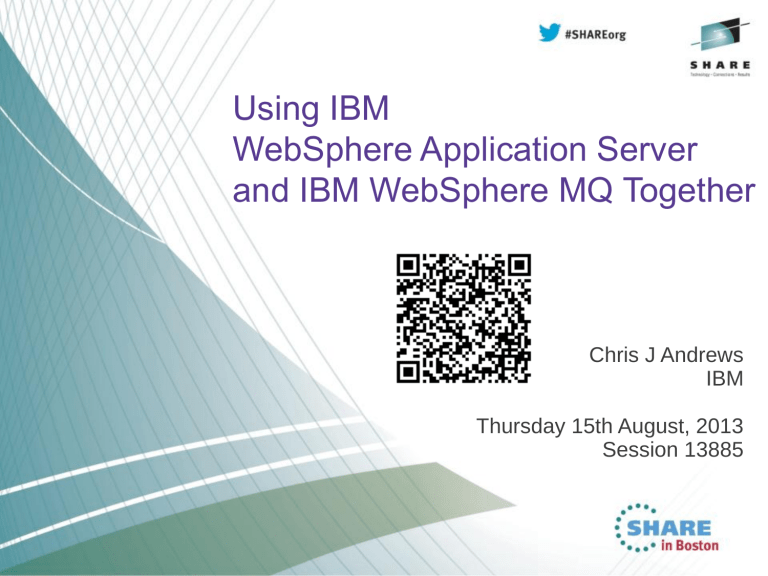
Using IBM
WebSphere Application Server
and IBM WebSphere MQ Together
Chris J Andrews
IBM
Thursday 15th August, 2013
Session 13885
2
Agenda
●
Why are we here?
●
Messaging in WAS
• What is JMS?
●
Accessing WMQ from WAS
• How to configure
• New WMQ V7 features useful for WAS
●
Configuring WMQ and WAS
• Useful tuning parameters
• High Availability and clusters
3
Why are we here?
Some reasons for being here...
“We currently have applications using WebSphere MQ, and
now we have applications running in WebSphere Application
Server that need to access the same data”
“We’re writing applications for WebSphere Application Server,
we’re trying to choose a messaging provider and are thinking
that WebSphere MQ might fit the bill”
…
4
How do we best communicate between WebSphere
Application Server and WebSphere MQ?
●
WebSphere Application Server is a fully compliant Java Enterprise
Edition (JEE) Application Server
• Provides integrated support for application messaging using Java
Message Service (JMS) providers.
●
WebSphere MQ is a fully compliant JMS provider.
●
Therefore, JMS is the answer!
5
Agenda
●
Why are we here?
●
Messaging in WAS
• What is JMS?
●
Accessing WMQ from WAS
• How to configure
• New WMQ V7 features useful for WAS
●
Configuring WMQ and WAS
• Useful tuning parameters
• High Availability and clusters
6
What is JMS?
●
A standardized Java API to allow applications to perform messaging
• Applications can be unaware of implementation
• Not a wire protocol!
●
Uses administered objects to define provider and configuration
• Can be changed without recompiling application
●
Supports point-to-point messaging, and publish/subscribe messaging
8
JMS Application
Connection
Session
Msg
MessageProducer
Connection
Factory 'QMGR'
Destination 'A'
Connection
Factory 'A'
Destination 'B'
Connection
Factory 'B'
Destination 'Q'
JMS Provider
How do JMS based applications function?
Queue Manager
'QMGR'
Queue 'Q'
Administrative Store
Application Server
9
Types of JMS applications in WAS
Message Driven Bean (MDB):
• Specific type of EJB which has an
“onMessage” Java method to process
messages
• JEE Container (WAS) deals with getting
the message, transactions, and running
the application.
WAS
MDB
Queue
• Mechanism to get messages into WAS
WAS
Enterprise Java Bean (EJB), Servlets/JSPs:
• Application creates connections and
sends/receives messages to WMQ
Servlet
HTTP
• Container provides connection pooling and
transaction management
Queue
11
Message Driven Beans disected
Method invoked when a message is available
public void onMessage(Message message) {
try {
if (message instanceof TextMessage) {
TextMessage textMsg = (TextMessage) message;
System.out.println("Message text is " +
textMsg.getText());
}
} catch (JMSException ex) {
System.out.println("JMSException occurred : " + ex);
}
}
12
Enterprise Java Beans (EJB)
@Resource()
private ConnectionFactory cf;
Define EJB 3 Resource references that
@Resource()
will be initialised at runtime
private Queue q;
More code required to get a message
public void receiveMessage() {
compared to an MDB, and less efficient
try {
Connection conn = cf.createConnection();
conn.start();
Session sess =
conn.createSession(true,Session.AUTO_ACKNOWLEDGE);
MessageConsumer consumer = sess.createConsumer(q);
Message msg = consumer.receive(30000);
if (msg instanceof TextMessage) {
System.out.println(“Message received:“ +
((TextMessage) msg).getText());
}
conn.close();
} catch (Exception ex) {
System.out.println("Exception : " + ex);
}}
13
WAS JMS messaging in a slide
●
WebSphere Application Server provides first class support for two JMS
messaging providers
• (1) An embedded messaging provider, the Default Messaging
provider (or Service Integration Bus)
• (2) WebSphere MQ
●
The nature of JMS and JEE allows easy switching between providers
with little or no application changes
WAS
Application
Server
Application
WebSphere MQ
Default
Messaging
18
Agenda
●
Why are we here?
●
Messaging in WAS
• What is JMS?
●
Accessing WMQ from WAS
• How to configure
• New WMQ V7 features useful for WAS
●
Configuring WMQ and WAS
• Useful tuning parameters
• High Availability and clusters
19
Ways of accessing WMQ from within WAS
Three key options:
1. Use WMQ as the JMS provider in WAS
2. Use the service integration bus in WAS and connect that
messaging system with your WMQ backbone
3. Use a mixture of both
– SIBus for intra-WAS messaging
– WMQ for inter-system messaging
20
Option 1:
WebSphere MQ as the JMS provider in WAS
WAS
Application
Server
Application
Applications
connect directly into
the WMQ backbone
WMQ
QMgr
Application
Server
Existing WMQ
application
CICS
application
Application
WMQ
QMgr
WMQ
QMgr
WMQ
QMgr
WMQ backbone
21
Option 1: WMQ as the JMS provider in WAS
●
Pros
• The most direct route to WMQ queues
• Best performing way to get messages on and off a WMQ queue
• Least moving parts
• Least things to configure
• Least places where things can go wrong
• A single messaging system to maintain rather than two
●
Cons
• WAS application deployment depends on knowledge of WMQ topology
• e.g. the WMQ queue location is required when connecting applications
• WAS applications dependent on two systems being simultaneously
available
• Can be complex to exploit WAS and WMQ high availability and scalability
features
22
Option 2:
SIBus for WAS application messaging
SIBus interacts with WMQ to access the messaging backbone
WAS
Application
Server
Application
Server
Application
Application
Messaging
Engine
Messaging
Engine
Application
Server
Application
SIBus
Messages flow
between SIBus and
WMQ where
interactions with the
WMQ backbone are
necessary
MQ Link
WMQ backbone
WMQ
QMgr
Existing WMQ
application
WMQ
QMgr
CICS
application
WMQ
QMgr
24
Option 2: SIBus messaging system
●
Pros
• Messaging runtime is embedded into the same runtime as the applications
• Ability to asynchronously queue messages in the WAS system while
connectivity with the WMQ backbone is unavailable
• JMS resource configuration relates to WAS-defined SIBus configuration
objects
• WMQ-aware configuration in WAS is minimised
• Applications can be unaware of actual queue locations
●
Cons
• Two messaging systems to configure and maintain
• Additional complexity in configuring interactions
between SIBus and WMQ
• Performance overhead when passing from one
messaging system to another
26
Option 3 : Mixture of both
SIBus for WAS-WAS application messaging,
WMQ for WAS-‘other’ messaging
WAS
Application
Server
Application
Server
Application
Server
Application
Application
Application
Messaging
Engine
Messaging
Engine
Application
SIBus
WMQ backbone
WMQ
QMgr
Existing WMQ
application
WMQ
QMgr
WMQ
QMgr
CICS
application
27
WebSphere MQ as the messaging provider in WAS 7+
●
Pre-deployed and ready to go
●
Fully integrated into WAS administrative tools
• Can even do limited WMQ administration from WAS
●
Access to WMQ via TCP or shared memory (“bindings”)
●
Supports connections to variety of WMQ queue manager versions
●
Interfaces with WAS using the well-defined JCA interface
• WebSphere MQ provided as a single unit “Resource Adapter”
●
WMQ Resource Adapter is a component of WAS
• Updates applied using WAS process, not WMQ
29
Configuring for WMQ : Connection Factories
Resources > JMS > Connection factories > [New]
•
•
Specify how an application
connects to a WMQ queue manager
Typically requires:
– Queue manager name
– Hostname and port
– Channel name
– Other parameters such as:
• Transport type (client or bindings)
• Use of SSL
•
Or, can use WMQ client channel
definition table (CCDT) URL
30
Configuring for WMQ : Destinations
Resources > JMS > Queues / Topics > [New]
•
Defines references to the resources in
WMQ that a JMS application will use
– The WMQ resources must be created
using WMQ administration
•
Queues
– Identifies the actual queue
in WMQ
• Can be used to set properties such
as persistence, priority, etc.
•
Topics
– Defines the WMQ publish/subscribe
destination
31
Configuring for WMQ : Activation Specifications
Resources > JMS > Activation Specifications > [New]
●
●
●
●
●
Activation Specs are the standardised
way of delivering messages to an MDB
The WebSphere MQ messaging provider
in WAS V7 adds support for Activation
Specifications
• Listener Port functionality is stabilized.
Activation Specs combine the
configuration of connectivity, the JMS
destination to be processed and the
runtime characteristics of the MDB itself
Can be tested during creation to verify
they work.
Activation specifications can be defined at
all WAS configuration scopes, as can be
done for ConnectionFactories and
Destinations.
35
Agenda
●
Why are we here?
●
Messaging in WAS
• What is JMS?
●
Accessing WMQ from WAS
• How to configure
• New WMQ V7 features useful for WAS
●
Configuring WMQ and WAS
• Useful tuning parameters
• High Availability and clusters
36
New functional areas in WMQ V7 of interest to JMS
●
Message Properties + Selectors
●
Asynchronous Consumption of messages
●
Simplified Browse + Co-operative Browse
●
Asynchronous Put Response
●
Read-ahead of messages
●
Connection changes
●
Multi-instance Queue Managers (WMQ 7.0.1)
37
Message properties and Selectors
●
JMS Selectors allow messages from a destination to be filtered
• Filter on system or user message properties
●
WMQ V7 queue manager understands JMS message properties
●
Queue manager evaluates JMS selector
• Only transmits matching messages to the client
• Efficient delivery of messages
JMS
Application
38
Asynchronous Consume
●
●
●
JMS has had the concept of asynchronous
consumer since inception
• MessageListener / onMessage code
Event driven processing ‘natural’ for the Java
Environment
WMQ V7 introduced ability of queue
manager to drive consumer when
suitable message available
• Avoids need for 'polling thread'
• More efficient message delivery,
especially with selectors.
AppServer
●
V6 Queue
Manager
MDB
AppServer
MDB
●
MQGET
With proper support in WMQ – JMS
implementation simplified
Less client CPU overhead of this busy thread
V7 Queue
Manager
39
Asynchronous Consumer and Browse-with-mark
●
●
Multiple application servers will contend for messages when
processing the same queue.
• Can result in failed message delivery and wasted resources
Browse-with-mark allows the application server to hide messages it
has browsed and intends to process
• No contention for messages, and improved
Queue
throughput.
Manager
●
The MDB browse thread always starts at top
• Message priority honoured
AppServer
AppServer
AppServer
MDB
MDB
MDB
41
WAS 8.5.5 – Liberty Profile
WAS 8.5 introduced a new 'lightweight' profile, called the “Liberty”
profile, intended for use by developers.
Out-of-the-box, the Liberty profile provides no WebSphere MQ
connectivity.
Instructions for obtaining the WMQ-RA:
http://www.ibm.com/support/docview.wss?uid=swg21633761
Requires WMQ-RA 7.5.0.1 + IC92914 (included in WMQ-RA 7.5.0.2)
http://www.ibm.com/support/docview.wss?uid=swg1IC92914
To correct problems with: various trace problems (NPE to formatting),
JMS UserID field could not be changed from the JVM process ID,
SHARECNVALLOWED property ineffective.
42
Agenda
●
Why are we here?
●
Messaging in WAS
• What is JMS?
●
Accessing WMQ from WAS
• How to configure
• New WMQ V7 features useful for WAS
●
Configuring WMQ and WAS
• Useful tuning parameters
• High Availability and clusters
44
Connection Name List
●
●
●
●
●
This property specifies a list of hostnames and ports to attempt to
connect to.
• Comma-separated list of “hostname(port)” entries
Entries in the list are tried until a working
connection is found, or the end of the list
is reached.
AppServer
Used with multi-instance queue managers
automatically reconnect to standby
MDB
Must be same QM data if using XA
Standard property in WAS V8
• WAS V7 custom property
Queue
Manager
Queue
Manager
Queue
Manager
46
Shared Conversation Allowed
●
This property specifies whether JMS applications that use this
Factory can share their connection to a Version 7+ queue manager.
Queue
Manager
Conn.
Conn.
Conn.
●
●
TCP Socket
JVM
Useful to reduce the number of network connections to a queue
manager.
Can have slight performance impact.
• Multiple JMS applications will be sending data to a queue manager
and waiting for a response over the same channel.
• Set server connection channel SHARECNV to 1 for maximum
performance for high data throughput JMS Connections.
48
Using WMQ JMS with existing WMQ applications
●
MQMD Read/Write enabled
• Determines if MQMD properties can be set via
JMS get/set message property methods.
• Allows full access to the MQMD header values
• Useful for sending or receiving messages from MQ
applications that use specific header properties.
• JMS message property names begin with
“JMS_IBM_MQMD…”
●
Target Client (JMS/MQ)
MQMD
• Indicates what the receiving application is
RFH2
• Removes the RFH2 header from sent
messages WMQ applications may
have issues with
MQMD
Data
Data
JMS Messages
Non-JMS Messages
50
Read Ahead Allowed
●
●
In general, messages are sent to JMS applications one at a time.
The Read Ahead Allowed property tells the queue manager whether
non-persistent messages can be streamed to the client application in
preparation for them being consumed.
• Messages are stored in a buffer on the client.
• If the client application terminates unexpectedly, all unconsumed
non-persistent messages are discarded.
JMS Application
JMS Client
Queue Manager
51
WAS Configuration: Activation Specifications
• How are messages destined for MDBs processed?
Thread
Server
Session
ServerSession
Pool
Thread
Pool
Queue Manager
Work Manager
WAS
Msg
Activation Specification
OnMessage()
Msg Ref.
Queue
52
Activation Specifications - Threads
●
●
●
●
To process a message, a ServerSession
and a thread is required
Activation Specification parameter
Maximum server sessions configures
ServerSession pool,
default 10
• ServerSession pool per MDB
Application Server Thread pool
WMQJCAResourceAdapter used,
default Maximum size 25
• Thread pool used by all MDBs.
So, by default, 3 MDBs could exhaust
the threads
• Will cause slower processing
• Recommendation is that thread pool
maximum accounts for all MDB
maximums
53
Activation Specifications - Recovery
●
●
●
●
What happens if the connection to a queue manager used by
Activation Specifications is broken?
The Activation Specification has recovery features to allow it to
attempt several reconnection attempts before stopping.
Default is to try 5 times in 5 minute intervals.
• Configured using reconnectionRetryCount /
reconnectionRetryInterval (ms) on the Resource Adapter, for all
Activation Specifications.
If the Activation Specification stops, this is only reported in Application
Server SystemOut.log logs.
54
Activation Specifications - Recovery
●
●
●
●
●
To configure WMQ RA settings, go to
Resources → Resource Adapters, select a scope to
configure, and in the Preferences, select
“Show built-in resources”, and Apply.
Select the “WebSphere MQ Resource Adapter”
Select custom properties, and modify the
“reconnectionRetryCount” and
“reconnectionRetryInterval” properties
Upon first failure, the RA will try an immediate
reconnection attempt, and if that fails, retry at the
configured interval.
The properties are configured on the RA, and so
affect ALL Activation Specifications using that
RA
55
JMS User authentication
createConnection(user,password)
●
●
In JEE, JMS application-specified user and
passwords are not necessarily used.
• “Container-managed” authentication
Activation Specifications / Connection
Factories can be associated with authentication data
• JAAS – J2C Authentication Data defines
username and password details
• The application needs to use JEE resource-references
to access the connection factory
• The authenticationType parameter needs to be set to
container for container-managed authentication.
●
As for other WMQ clients, security exits are required to
validate passwords, WMQ only checks user id
• User ids more important with WMQ 7.1 channel
authentication
57
Agenda
●
Why are we here?
●
Messaging in WAS
• What is JMS?
●
Accessing WMQ from WAS
• How to configure
• New WMQ V7 features useful for WAS
●
Configuring WMQ and WAS
• Useful tuning parameters
• High Availability and clusters
58
High Availability
●
●
Treat WAS and WMQ as separate resources
WMQ V7.0.1 features make it easier for WAS to reconnect during
failover
• Quicker detection of broken connections
• Connection Name Lists
●
OS-level HA solutions (HACMP etc.)
• Active – Passive failover
• Transparent as resources such as IP addresses are moved over
• Can include WMQ as well as other resources in the same failover
• Third party solution, introduces expense
59
Multi-instance Queue Managers
●
WMQ's implementation of Active – Passive failover
• Only moves WMQ resources
• Can be faster than OS-level HA
●
Needs data to be stored in external storage with locking, such as
NFS V4
●
One active queue manager, with other standby instance
●
Standby instance can detect failure and take over
• Can also trigger failover
●
Same data is shared, so it's the SAME queue manager.
Server 1
Queue
Manager
Server 2
QM Data
Queue
Manager
61
Multi-instance and Java EE
●
Connection to Multi-Instance Queue Managers is supported
• Minimum of WAS 7.0.0.13 required (contains WMQ 7.0.1.3)
• Can be configured using CCDT
• Can be configured using Connection Name Lists
●
Automatic Client Reconnect is not supported (in EJB/Web container)
• MDB based applications use ListenerPort/Activation Specification based
reconnection
• Automatic Client Reconnect can be used in unmanaged/client environments
62
High Availability continued...
●
Active – Active WMQ
• Multiple active running queue managers
• Provides service resilience and load balancing
• e.g. WMQ Clusters, z/OS Queue Sharing Groups (QSG)
• Can have stranded messages problems if queue manager
becomes unavailable.
• Can use HACMP/Multi-instance queue managers to avoid
Server 1
Queue
Manager A
Queue
Manager B
Server 2
QM A Data
QM B Data
Queue
Manager A
Queue
Manager B
63
Useful Information: Product Connectivity Scenarios
●
●
●
Scenario-based instructions for implementing a solution in a business
context
Providing a thorough, complete, and single end-to-end main path from
the business need (high level) to the tasks (low level)
Optional features help you learn as you progress through each task
– Information about why you are instructed to do something
– Information about what else you might do, or want to learn about,
related to what you are reading in the main window
●
Includes samples that you can try out and adapt
http://publib.boulder.ibm.com/infocenter/prodconn/v1r0m0/index.jsp
65
Further Information
●
WAS product information : http://www-306.ibm.com/software/webservers/appserv/was/
WAS Information Centers :
6.0 http://publib.boulder.ibm.com/infocenter/wasinfo/v6r0/index.jsp
6.1 http://publib.boulder.ibm.com/infocenter/wasinfo/v6r1/index.jsp
7.0 http://publib.boulder.ibm.com/infocenter/wasinfo/v7r0/index.jsp
8.0 http://publib.boulder.ibm.com/infocenter/wasinfo/v8r0/index.jsp
8.5 http://publib.boulder.ibm.com/infocenter/wasinfo/v8r5/index.jsp
Product Connectivity Information Center
http://publib.boulder.ibm.com/infocenter/prodconn/v1r0m0/index.jsp
Using WebSphere MQ Java Interfaces in J2EE/JEE Environments
http://www-01.ibm.com/support/docview.wss?rs=171&uid=swg21266535
IBM developerWorks : http://www.ibm.com/developerworks
(Searching on “Service Integration Bus” returns a number of interesting articles)
http://www.ibm.com/developerworks/websphere/techjournal/0901_leming/0901_leming.html - WASV7
http://www.ibm.com/developerworks/websphere/techjournal/0601_ratnasinghe/0601_ratnasinghe.html - Security
http://www.ibm.com/developerworks/websphere/techjournal/0601_smithson/0601_smithson.html - Security
IBM RedBooks : http://www.redbooks.ibm.com
WebSphere Application Server V7: Messaging Administration Guide SG24-7770-00
WebSphere Application Server V7: Concepts, Planning and Design, SG24-7708-00
WebSphere Application Server V7: Technical Overview, REDP-4482-00
WebSphere Application Server V6.1: JMS Problem Determination, REDP-4330-00
WebSphere Application Server V6.1: System Management & Configuration, SG24-7304-00
WebSphere Application Server V6 Scalability and Performance Handbook, SG24-6392-00
WebSphere Application Server V6.1 Security Handbook, SG24-6316-01
WebSphere Application Server V6.1: Technical Overview, REDP-4191-00
WebSphere Application Server V6.1: Planning and Design, SG24-7305-00
WebSphere Application Server V6.1: Installation Problem Determination, REDP-4305-00
67
This was session 13787 - The rest of the week ……
Monday
Tuesday
Wednesday
Extending IBM WebSphere
MQ and WebSphere
Message Broker to the
Cloud
08:00
09:30
Thursday
Introduction to MQ
Hands-on Lab for MQ - take
your pick!
MOBILE connectivity with
Broker
Using IBM WebSphere
Application Server and
IBM WebSphere MQ
Together
12:15
1:30
MQ Parallel Sysplex
What’s New in the MQ
Exploitation, Getting the
Family
Best Availability From MQ on
z/OS by Using Shared
Queues
MQ Clustering - The basics,
advances and what's new
3:00
First Steps With Message
Broker: Application
Integration for the Messy
What's New in Message
Broker
BIG Connectivity with mobile WebSphere MQ CHINIT
MQ
Internals
4:30
What's available in MQ and
Broker for high availability
and disaster recovery?
The Dark Side of Monitoring
MQ - SMF 115 and 116
Record Reading and
Interpretation
MQ & DB2 – MQ Verbs in
DB2 & Q-Replication
performance
6:00
CICS and WMQ - The
Resurrection of Useful
Can I Consolidate My Queue
Managers and Brokers?
MQ on z/OS - Vivisection
11:00
Friday
Big Data Sharing with the
Cloud - WebSphere eXtreme
Scale and IBM Integration
Bus Integration
WebSphere MQ Channel
Authentication Records
Migration and Maintenance,
the Necessary Evil. Into the
Dark for MQ and Message
Broker
68
69
Copyright and Trademarks
© IBM Corporation 2013. All Rights Reserved.
IBM, the IBM logo, and ibm.com are trademarks or
registered trademarks of International Business Machines
Corp., registered in many jurisdictions worldwide. Other
product and service names might be trademarks of IBM or
other companies. A current list of IBM trademarks is
available on the Web at “Copyright and trademark
information” at www.ibm.com/legal/copytrade.shtml.

